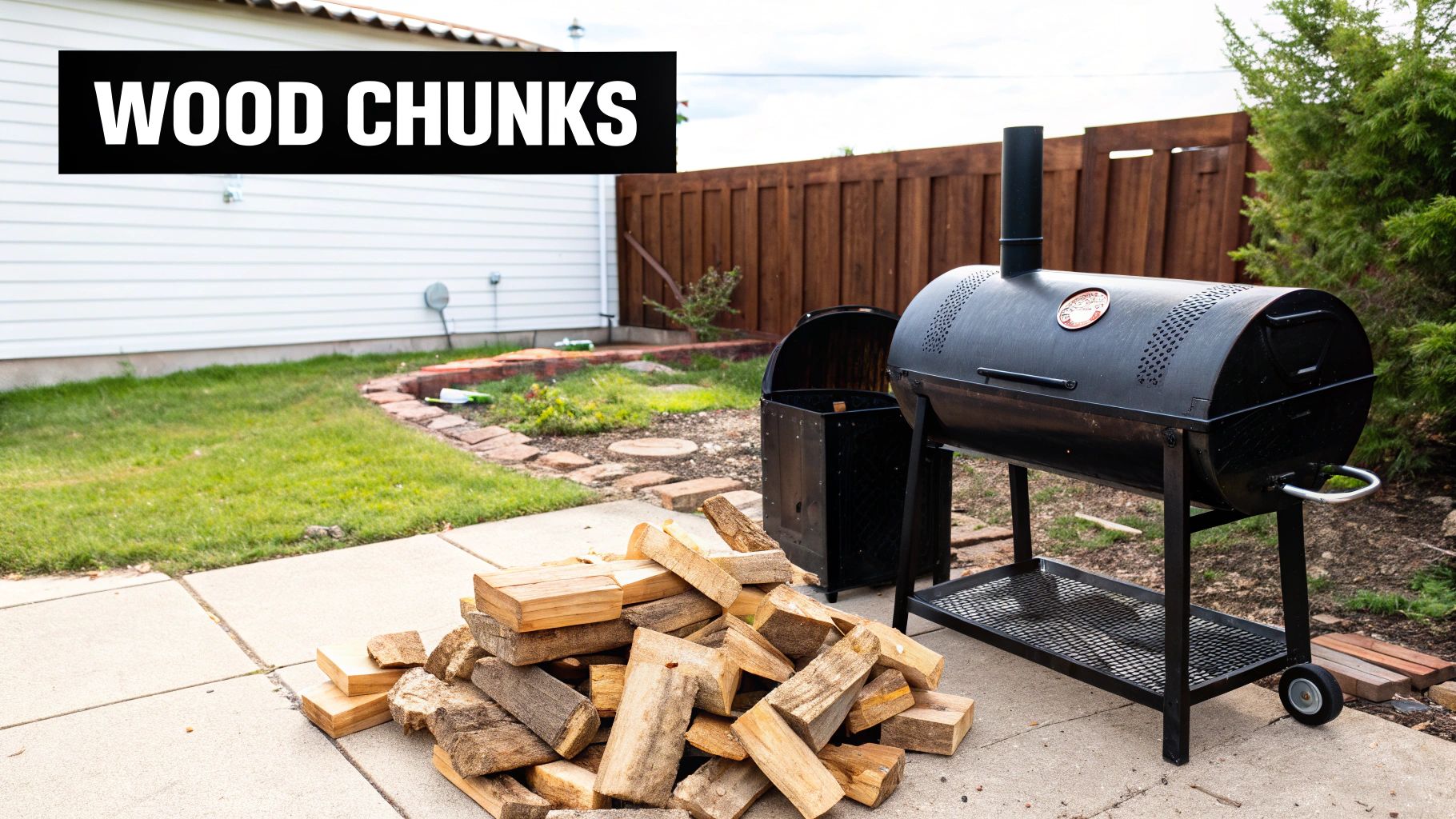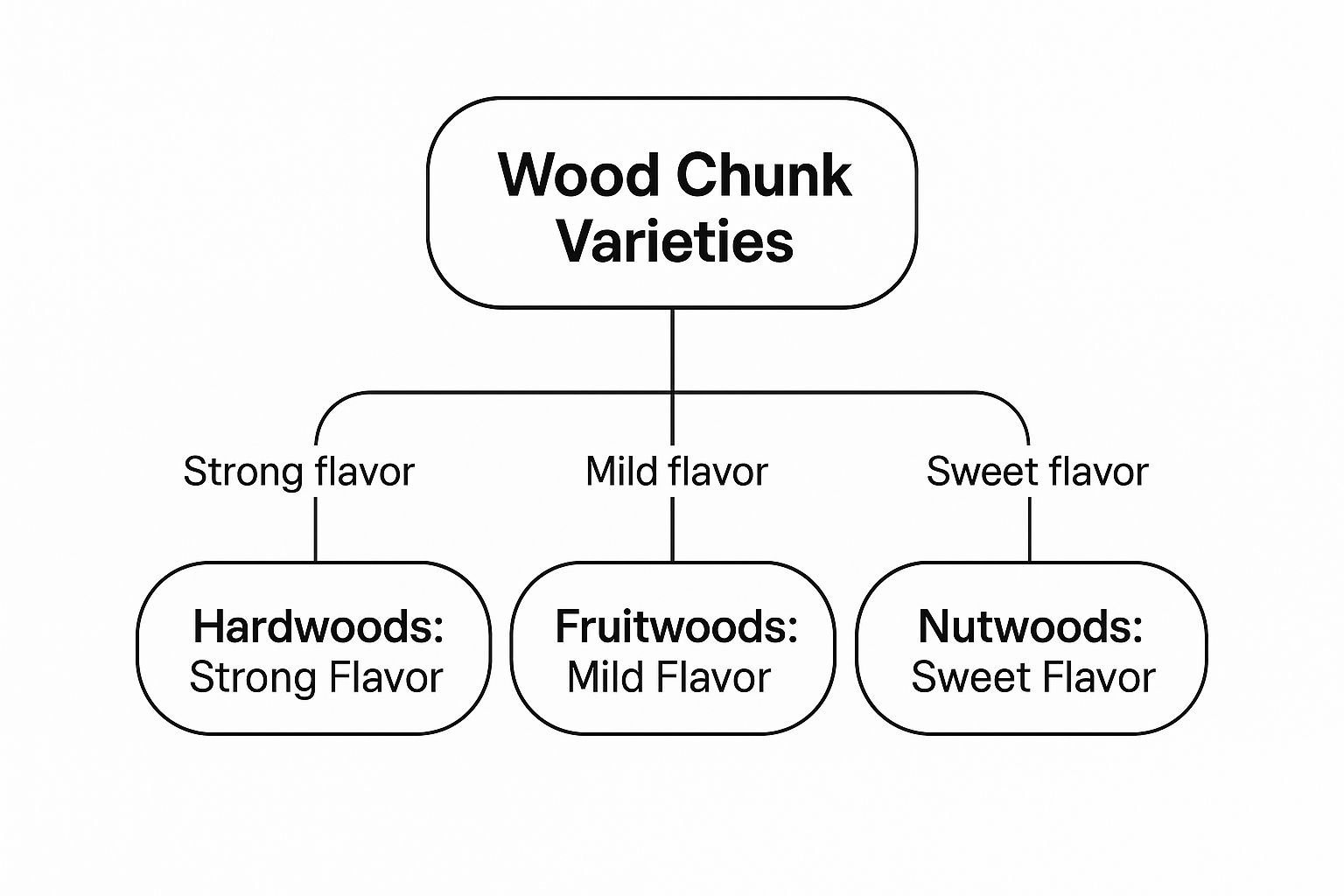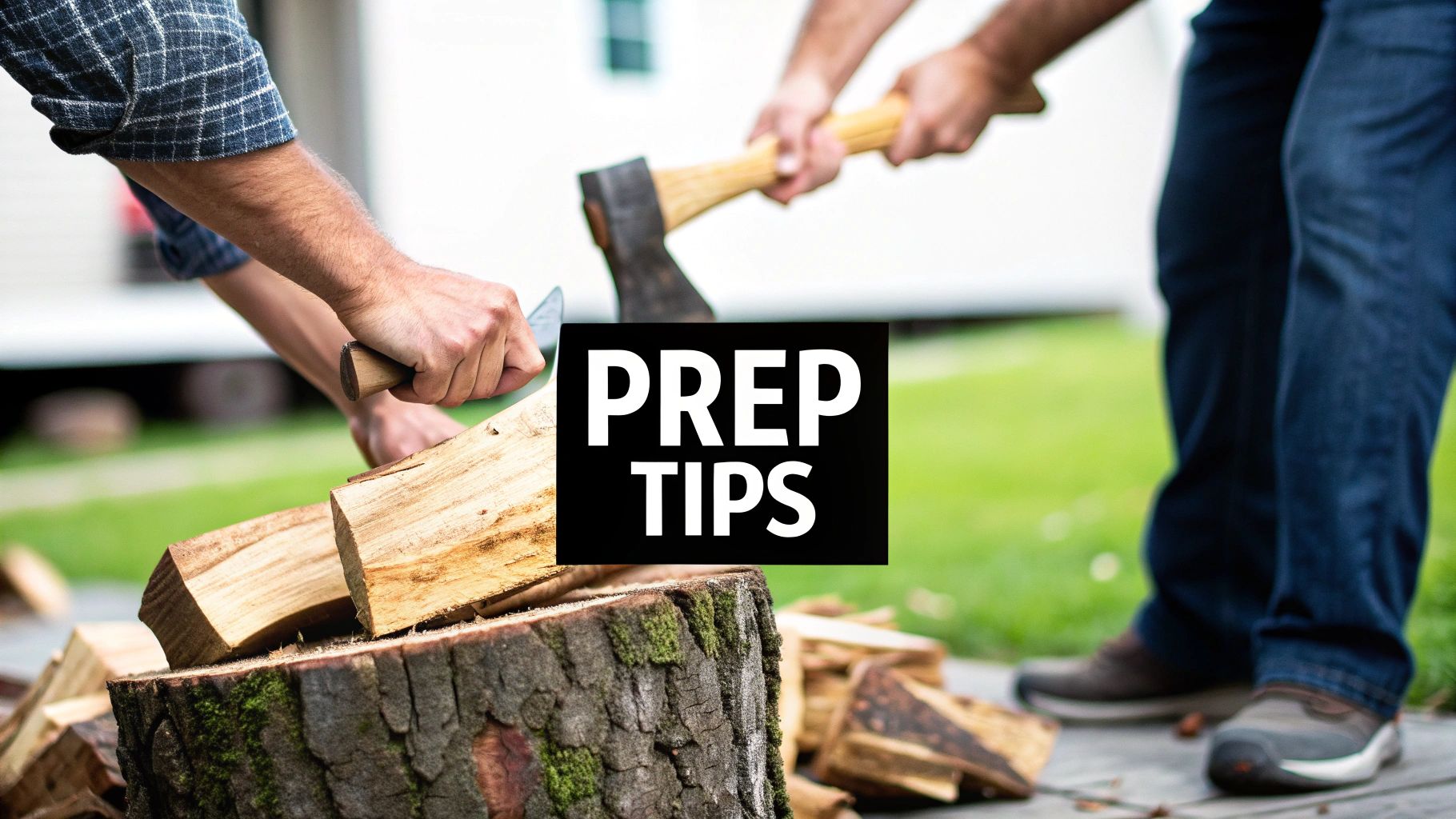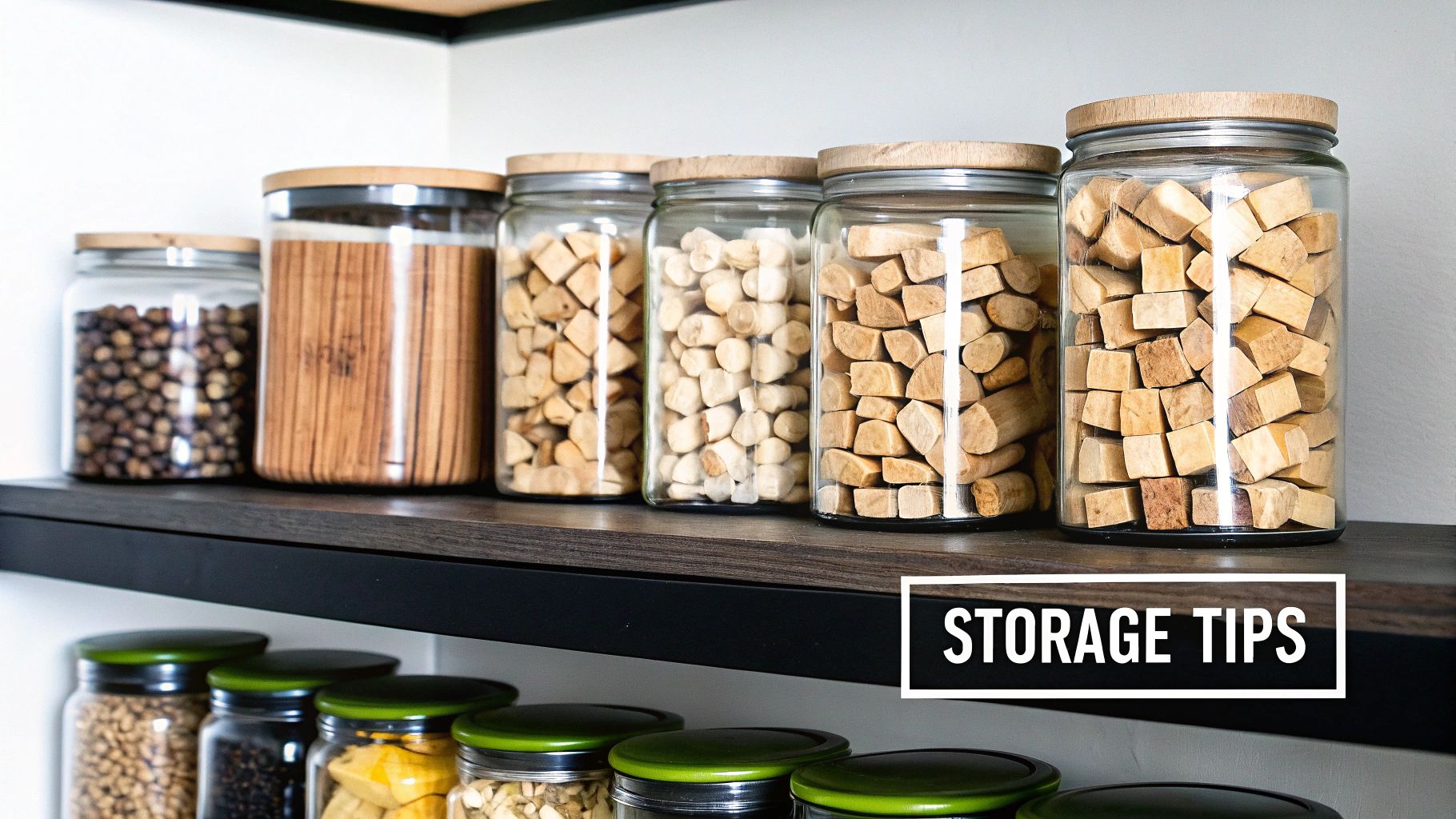A Complete Guide to Wood Chunks for Smokers
Ready to unlock some serious smoke flavour? Wood chunks for smokers are the real deal for low-and-slow barbecue, giving you a steady, long-lasting smoke that tiny wood chips just can’t touch. Think of them as slow-release flavour bombs, perfect for turning brisket, pork shoulder, and ribs into something legendary.
Why Wood Chunks Are a Smoker's Best Friend

If you're chasing that deep, authentic barbecue taste—the kind that gets right into every fibre of the meat—then wood chunks are a must-have. Unlike smaller wood chips that ignite and burn out in a flash, chunks are the marathon runners of the flavour world.
Their size and density mean they smoulder away for hours, providing the consistent, clean smoke that’s absolutely crucial for long cooks. It’s this slow, gentle release of smoky goodness that creates the famous "smoke ring" and builds those incredible layers of flavour. It’s what separates a simple grilled steak from a brisket that tells a story with every single bite.
The Rise of Real BBQ in the UK
Here in the UK, the love for proper smoking is exploding. What used to be a niche hobby is now a full-blown culinary movement, with home cooks and family-focused food explorers keen to get authentic smokehouse results in their own back gardens.
This shift has put wood chunks for smokers firmly in the spotlight. Barbecue enthusiasts across the country are turning to smoking wood to level up their cooking, reflecting a nationwide passion for creating proper, flavour-packed meals from scratch. It’s all about crafting authentic cultural flavours, free from the mass-produced taste and with no added crap.
What This Means for Your Next Cookout
Choosing wood chunks is a conscious decision to take control of your cook. It’s about dialling in the flavour and creating a signature taste that’s all your own. When you use quality wood chunks, you’re not just cooking—you’re building character into your food.
For anyone serious about barbecue, wood chunks are the foundation. They deliver the steady, clean smoke needed to turn tough cuts like brisket and pork shoulder into tender, flavourful masterpieces.
Think of this guide as your complete roadmap. We’ll walk you through everything, from picking the perfect wood for your meat to mastering the techniques for flawless smoke. Let’s make sure your next BBQ is your best one yet.
Finding Your Perfect Wood Flavour Profile
Let's get one thing straight: not all smoke is created equal. Think of wood chunks as the spice rack for your smoker—each one brings a totally unique character to the party. Nailing the right wood chunks for smokers is your first step to crafting that signature flavour that’ll have everyone begging for your secret.
The whole game is about understanding which woods play nicely with which foods.
This little map gives you a great visual breakdown of the main flavour groups you'll be working with.

It splits everything into three camps: the strong hardwoods, the gentler fruitwoods, and the sweet nutwoods. Use this as your starting point. Once you get the hang of it, you can start mixing and matching to create something that’s all your own.
Wood Chunk Flavour and Food Pairing Chart
To make it even easier, here's a quick-reference chart. Keep this handy when you're planning your next cook.
| Wood Type | Flavour Profile | Intensity | Best Paired With |
|---|---|---|---|
| Hickory | Strong, savoury, bacon-like | High | Pork (ribs, shoulder), beef |
| Oak | Medium, classic smoky | Medium | Beef (brisket), lamb, sausages |
| Mesquite | Bold, earthy, intense | Very High | Steaks, red meat, quick grills |
| Apple | Mild, subtly sweet, fruity | Low | Pork, chicken, fish |
| Cherry | Mild, rich, slightly sweet | Low-Medium | Chicken, turkey, ham, pork |
This isn't a set of hard-and-fast rules, but it’s a brilliant guide to get you started on the right track.
Bold and Robust Hardwoods
These are the heavyweights of the smoking world. Hardwoods pack a serious punch with strong, assertive flavours, making them the go-to for big, beefy cuts that can handle some intense smoke.
- Hickory: The undisputed king of classic barbecue. Hickory delivers a powerful, almost bacon-like flavour that’s savoury and intense. It's an absolute dream with pork ribs and shoulders, but go easy—it can easily overpower more delicate foods.
- Oak: Think of oak as the reliable all-rounder. It gives you a solid, medium smoke that’s less in-your-face than hickory. This makes it a perfect partner for beef, especially brisket, because it complements the meat without completely masking its natural taste.
- Mesquite: The boldest of the lot. Mesquite has a unique, earthy flavour that’s famous in Texan barbecue. It’s ideal for grilling steaks or anything you're cooking fast and hot, as that massive flavour develops in no time.
Mild and Sweet Fruitwoods
On the other end of the spectrum, you’ve got the fruitwoods. These offer a much gentler, sweeter, and more subtle smoke. Their mellow character makes them incredibly versatile and a perfect starting point if you're new to all this. They work wonders on poultry, pork, and even fish.
- Apple: This one produces a very mild smoke with a lovely hint of sweetness. Apple wood is exceptional with pork and chicken, slowly infusing the meat with a delicate, fruity aroma that never feels overwhelming.
- Cherry: Similar to apple but a touch richer. Cherry is brilliant because it adds a beautiful dark reddish tint to your food. It’s a top choice for chicken, turkey, and ham, and it really shines when you mix it with a stronger wood like hickory to add another layer of complexity.
How to Create the Perfect Smoke for BBQ Pulled Pork in 3 Steps:
- Choose your wood: Grab a 70/30 mix of hickory and apple wood chunks.
- Set up your smoker: Once your charcoal is ready, add 3-4 chunks of the hickory/apple blend on top.
- Smoke the pork: Wait for the smoke to turn thin and blue, then place your seasoned pork shoulder on the grates. The hickory provides the classic BBQ punch while the apple adds a subtle sweetness for a perfectly balanced flavour.
At the end of the day, the only way to find your perfect profile is to get out there and cook. Start with these classic pairings, but don't be afraid to break the rules and try new combinations. That's how you'll stumble upon the signature flavours that make your barbecue truly unforgettable.
How to Use Wood Chunks for Flawless Smoke

Right, you’ve picked your wood. Now for the fun part: putting it to work. Getting this bit right is what separates legendary barbecue from the forgettable stuff. It’s all about coaxing out a clean, consistent smoke that kisses your food with flavour instead of punching it in the face.
The good news? It’s a straightforward process, no matter what kind of smoker you’re running. Nail a few key steps, and you’ll be on your way to that perfect, wispy blue smoke all the pitmasters chase.
Settling the Great Soaking Debate
Let’s get this out of the way first: do not soak your wood chunks. It’s one of the most stubborn myths in barbecue, and honestly, it does more harm than good for low-and-slow cooking.
Think about it. When you put wet wood on a fire, it doesn't smoke. It steams. All that water has to boil off before the wood can actually start smouldering, which messes with your smoker’s temperature and stalls your cook. Worse, that steamy, smouldering phase produces a thick, white, acrid smoke that leaves a bitter taste on your food.
For clean, authentic smoke flavour, always use your chunks completely dry.
Achieving That Perfect Thin Blue Smoke
This is the holy grail of smoking. “Thin blue smoke” is that almost-invisible wisp you see shimmering off the coals. It’s where all the flavour lives, free from the harsh, bitter compounds you get with thick, billowing white smoke.
Here’s a simple, no-nonsense way to get it right every time:
- Get Your Fire Ready: Light your charcoal and let it settle into a stable temperature. You’re looking for glowing coals covered in a light dusting of white ash—that’s the sweet spot.
- Place Your Chunks: Add 2-4 dry wood chunks right on top of the hot coals. Don't bury them. Placing them on top lets them smoulder slowly and combust cleanly. Spacing them out a bit also helps them ignite at different times, giving you a longer, more consistent smoke.
- Wait for the Smoke to Clean Up: The chunks will chuck out a load of thick, white smoke at first. Do not put your meat on yet! Give it 10-15 minutes. You’ll see the smoke thin out until it becomes a faint, bluish haze with a sweet, woody smell. That’s your green light.
The key is patience. Rushing things and letting your food get hit with that initial blast of dirty smoke is a classic beginner mistake. Always wait for that clean, thin blue smoke before the meat goes anywhere near the grill.
Managing your smoker’s vents is also a massive part of keeping this perfect smoke going. Too little airflow chokes the fire and creates bitter smoke; too much makes the wood burn up in a flash. Get those fundamentals dialled in, and you’ll taste the difference.
Sourcing and Storing Your Wood Chunks Properly
Great barbecue starts with great ingredients, and that absolutely includes your wood. The quality of the wood chunks for smokers you choose has a massive impact on the final flavour of your food. Tracking down high-quality, properly seasoned wood isn't just a minor detail—it's the first step to getting that clean, authentic smoke taste we’re all chasing.
Think of your wood chunks like you would fresh produce; you want the best possible selection. Before you buy, always give the wood a good look over. It should be clean, dry, and totally free from any signs of mould, mildew, or little critters.
If it looks a bit damp, feels soft, or you can see any fungal growth, leave it on the shelf. Those imperfections will only create nasty, bitter smoke, ruining your cook before you’ve even lit the coals.
Kiln-Dried Versus Air-Dried Chunks
You’ll often see wood chunks labelled as either kiln-dried or air-dried. It’s worth knowing the difference.
- Kiln-Dried Wood: This wood is dried in a controlled, heated environment. The process is quick, consistent, and kills off any lurking pests or mould. The end result is a chunk with very low moisture content, guaranteeing a clean, efficient burn straight out of the bag.
- Air-Dried (Seasoned) Wood: This is the old-school way. The wood is seasoned naturally over a long time, sometimes up to a year. It works, but the moisture content can be less consistent. There's also a slightly higher risk of it hiding mould or pests if the supplier hasn’t stored it perfectly.
For pure reliability, kiln-dried is usually the safest bet, especially if you're just starting out. It gives you a predictable performance every single time you fire up the smoker.
Storing Your Wood Chunks for Lasting Flavour
Once you’ve got your wood chunks home, storing them properly is key to protecting your investment. The goal is simple: keep them dry and let them breathe. Moisture is the number one enemy of good smoking wood, as it leads to mould and rot.
The golden rule for storage is to find a spot that’s dry, elevated off the ground, and well-ventilated. A shelf in the garage, a covered shed, or a waterproof deck box are all brilliant options. Whatever you do, never seal them in an airtight plastic container—that just traps moisture and is a recipe for mould.
This kind of attention to detail is part of a bigger picture in the UK, where more of us are getting into nuanced, exciting flavours. It's about taking pride in your craft, from the fuel you use to the seasonings on your meat. The Smokey Rebel ethos is built on this—using authentic ingredients with no added crap to create something special.
Getting your sourcing and storage right ensures every chunk is ready to deliver pure, clean smoke when you need it. It’s a simple habit that makes a world of difference. And if you're also exploring other fuel types, our guide on wood pellets offers similar tips for keeping them in top condition.
Advanced Techniques for the Flavour Pioneer
Once you’ve got the basics dialled in, the real fun begins. This is where you graduate from simply following recipes to crafting your own signature flavours. Mastering these advanced techniques with wood chunks for smokers is your ticket to building layers of complexity and taking your barbecue to a whole new level.
Think of this as your official invitation to become a flavour pioneer. When you understand how to blend woods and control your smoke, you can create results that are uniquely, undeniably yours.
Creating Complex Flavour by Blending Woods
Treat your wood chunks like a spice rack. Just as a chef blends spices, you can blend woods to create a custom smoke profile that’s far more nuanced and interesting than anything a single wood can offer on its own.
A brilliant place to start is by pairing a strong, assertive hardwood with a milder, sweeter fruitwood. This simple trick lays down a balanced foundation with a beautifully rounded finish.
- For BBQ Ribs: Go for a blend of 70% hickory and 30% apple. The hickory lands that classic, robust barbecue punch, while the apple comes in to soften the edges with a whisper of sweetness.
- For Beef Brisket: A mix of 60% oak and 40% cherry is a winning combination. Oak delivers a solid, medium smoke that stands up to beef perfectly, and the cherry adds that incredible deep colour and a subtle, fruity note to the bark.
- For BBQ Chicken: Try a gentler blend of 50% apple and 50% cherry. This creates a beautiful, sweet-and-fruity smoke that complements poultry perfectly without overpowering it.
The key is to let one wood be the star of the show while the other plays a supporting role. Always start with a dominant base flavour, then introduce a secondary wood to add a specific accent or highlight.
Managing Smoke Intensity on Long Cooks
When you’re tackling a marathon cook like a whole brisket or a pork butt, you don’t want to be blasting it with heavy smoke for the entire time. It’s a common rookie mistake. The truth is, meat only really absorbs smoke for the first few hours, typically until its internal temperature hits around 60°C (140°F).
Pushing heavy smoke beyond that point won't add any more good flavour—it just risks turning your beautiful bark into a bitter, acrid mess.
The solution? Front-load your smoke. Get all your wood chunks in at the very start of the cook. This ensures the meat gets a good, clean dose of flavour when it’s most receptive. After the first 3-4 hours, you can just let the chunks burn out and finish the cook with pure charcoal heat. This technique gives you a clean, deep smoke flavour without any harshness.
An Introduction to Cold Smoking
Now, cold smoking is a completely different ball game. With this method, the goal is to infuse incredible smoke flavour without actually cooking the food. The whole process is done at super-low temperatures, well below 30°C (90°F), making it perfect for more delicate items.
It's an amazing technique for things like:
- Cheese (think cheddar or Gouda)
- Salmon
- Nuts and spices
- Even butter!
To pull it off, you need a way to generate smoke without generating much heat, which usually means using a separate cold smoke generator. It's a fantastic way to push the boundaries of what you thought your smoker could do.
FAQs: Your Questions on Wood Chunks Answered

Even the most seasoned pitmasters have questions. When you're dialling in your technique, a few common queries always come up about using wood chunks for smokers. Think of this as your go-to troubleshooter for those little details that can make or break a cook.
Getting these things right is what separates a good BBQ from a great one. Let's clear up a few of the most common head-scratchers.
How Many Wood Chunks Should I Use?
This is the classic question, and honestly, there's no single magic number. It all depends on your smoker, how long you're cooking for, and just how much smoke flavour you're chasing. But here's a solid rule of thumb to get you started: less is more. You can always add another chunk, but you can't take smoke away.
A good starting point for most setups is:
- For shorter cooks (2-4 hours): Kick off with 2-3 chunks. This is spot-on for things like chicken or ribs, where you want a clean kiss of smoke, not a smack in the face.
- For longer cooks (6+ hours): Go for 4-6 chunks. For the big boys like brisket or a pork shoulder, this gives you a steady, consistent smoke during those all-important first few hours.
If you notice the smoke thinning out too soon, just toss another chunk on the coals. Easy.
Should I Soak Wood Chunks Before Smoking?
Let's put this one to bed for good: absolutely not. Soaking your wood chunks is one of the biggest myths in BBQ. Soaked wood doesn't create smoke; it just creates a load of steam.
When you put wet wood on hot coals, your smoker has to waste energy boiling off all that water before the wood even thinks about smouldering. This nukes your temperature and produces a thick, acrid white smoke that'll leave your food tasting bitter. For that beautiful, clean "thin blue" smoke, your chunks need to be bone dry.
Can I Use Wood From My Garden?
This one's a major safety alert. While it might feel thrifty to use a log from the back garden, it's a huge gamble. You should only ever use hardwoods that have been specifically sourced and seasoned for cooking.
Loads of common garden trees, especially sappy softwoods like pine, fir, or cedar, release toxic compounds when they burn. Breathing in that smoke or eating food cooked over it is seriously bad news. Stick to food-safe wood chunks for smokers from a trusted supplier. It guarantees you get incredible flavour without any of the risks.
Never, ever risk it with mystery wood. The clean, rich flavour from proper oak, hickory, or cherry is worlds apart—and, more importantly, it's 100% safe for you and your family.
What Is the Difference Between Chunks and Chips?
It all boils down to size, which dictates how they burn. Think of it like building a campfire.
- Wood Chunks are your logs. They're big and dense, so they smoulder away slowly, releasing a steady stream of smoke over hours. This makes them the undisputed champion for low-and-slow cooks where consistency is everything.
- Wood Chips are your kindling. They're small, thin, and catch fire in a flash, burning out just as quickly. They're great for a quick burst of intense smoke, which is why they're better suited for grilling, not true smoking.
Ready to create your own authentic smoke flavours? At Smokey Rebel, we're obsessed with quality. Our seasonings are crafted in small batches with no added crap, so you only get pure, incredible taste.
Explore the full Smokey Rebel range today and taste the difference for yourself.
Join our Mailing List
Sign up and get Smokey Rebel Recipes + weekly recipes straight to your inbox!
Recent articles
Best BBQ Seasoning Gift Sets for Every Grill Master
Discover the best BBQ seasoning gift sets for any occasion. Find curated flavour collections perfect for grill lovers and adventurous...
Read moreHow to Make BBQ Rub: A Step-by-Step Guide to Perfect Flavour
Learn how to make BBQ rub at home with easy tips. Discover flavor ideas and create irresistible seasonings for your...
Read moreThe Ultimate Pulled Pork Rub Recipe
Discover the ultimate pulled pork rub recipe for authentic BBQ flavour. Learn how to mix, apply, and adapt your rub...
Read more


